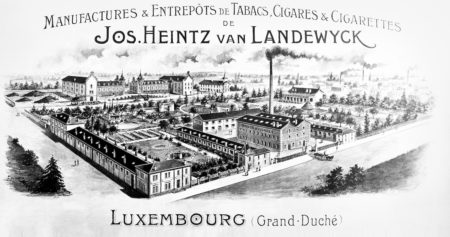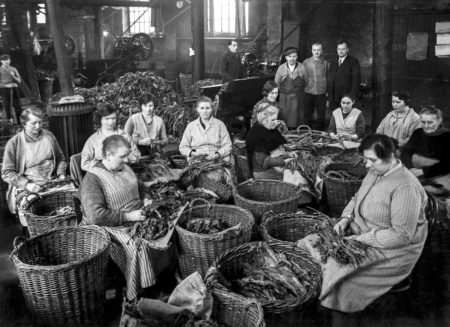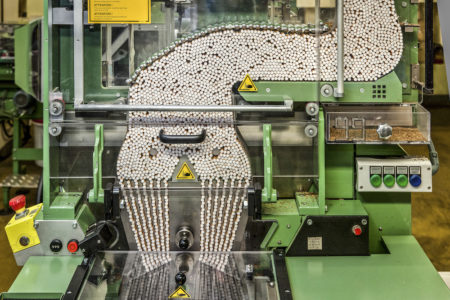 In the first half of the 19th century, when the London Treaty of 1839 established Luxembourg’s current borders, some 40 tobacco producers were active in Luxembourg. Among them, Jean-Pierre Heintz, barely 25 years old, who opened in 1847 a shop in the city centre annexed to a small factory. The name of his wife, Josephine Heintz van Landewyck, already appeared on the sign, giving it a certain cachet, as Dutch tobacco then enjoyed an excellent reputation.
In the first half of the 19th century, when the London Treaty of 1839 established Luxembourg’s current borders, some 40 tobacco producers were active in Luxembourg. Among them, Jean-Pierre Heintz, barely 25 years old, who opened in 1847 a shop in the city centre annexed to a small factory. The name of his wife, Josephine Heintz van Landewyck, already appeared on the sign, giving it a certain cachet, as Dutch tobacco then enjoyed an excellent reputation.
The business quickly became successful and in 1867, in rented and recently demilitarised premises in the central building of Fort Berlaimont, Jean-Pierre Heintz installed a small steam engine, the first of its kind in the country. This was the beginning of the industrial era in this market.
Joseph, the son of Jean-Pierre and Josephine, entered the race very quickly and continued to drive the prosperity of the family business. The acquisition of fields in Hollerich (on the outskirts of the City) allowed him to bring all the production activities to a single site, inaugurated in 1897, five years after the death of Jean-Pierre. Some 250 workers then produced 100,000 cigars and two tons of smoking tobacco of all kinds. In addition, about a hundred workers produced between 100,000 and 300,000 cigars a week at another site in Larochette.
Social dimension
 Victor, son of Joseph (who died in 1912), took over the business and introduced in 1905 the first semi-automatic cigarette machine in Hollerich. He also exceled with his great humanism, creating and animating for many years the ‘popular soup kitchen’ in rue des Bains and renovating at his own expense a part of the Place d’Armes which was under threat of collapse.
Victor, son of Joseph (who died in 1912), took over the business and introduced in 1905 the first semi-automatic cigarette machine in Hollerich. He also exceled with his great humanism, creating and animating for many years the ‘popular soup kitchen’ in rue des Bains and renovating at his own expense a part of the Place d’Armes which was under threat of collapse.
At the end of the First World War, the end of the customs agreement with the Germans which existed since the middle of the 19th century pushed the company to move some production machines to Trier and open a small branch. Within a few years, it became the second German manufacturer of cigarette tobacco.
When Victor Heintz died in 1931, aged 52, he did not have a direct descendant. The succession was assured by his brother-in-law, Aloyse Meyer, then Managing Director of the Arbed and President of the Chamber of Commerce, who appointed Gustave Koener from the outside as director at the Hollerich factory. Quickly, a certain Robert Meyer, entered the company in 1934, as co-director.
After the death of Aloyse Meyer in 1952 and the retirement of Gustave Koener in the same year, he took over sole management of the company.
Diversification
 In 1964, HvL inaugurated a state-of-the-art factory in Ettelbruck and manufactured US cigarettes under licence. Three years later, Marc Meyer, grandson of Aloyse and cousin of Max Meyer, joined the company, then Charles Krombach arrived, the son-in-law of Robert Meyer. Mr Krombach quickly became managing director and then CEO of the company.
In 1964, HvL inaugurated a state-of-the-art factory in Ettelbruck and manufactured US cigarettes under licence. Three years later, Marc Meyer, grandson of Aloyse and cousin of Max Meyer, joined the company, then Charles Krombach arrived, the son-in-law of Robert Meyer. Mr Krombach quickly became managing director and then CEO of the company.
The firm was gradually diversifying and positioning itself in the logistics / distribution segment to the point of becoming, in the mid-80s, the country’s largest wholesaler in the sector. At that time, between its factories in Hollerich (250 people), Ettelbruck (100) and Trier (150), it manufactured 3.5 billion cigarettes sold mainly in Benelux.
The brands Bentley (Southeast Asia) and Ducal (West Africa) boosted production to 5.3 billion in 1992, when the company launched the “Rolls” (tobacco to roll one’s own cigarettes) in Germany, which was less taxed than cigarettes. Exports expanded eastwards and a new production record was established in 1996, with 5.7 billion cigarettes.
A new era on the way
Two years later the Elixyr brand was launched, now available in 30 countries, while the geographic expansion continued: the takeover of the Dutch Biggelaar Tabak in 2001, merger with the Belgian Torrekens Tabakindustrie in 2007, establishment of Landewyck France in 2009 to manage the distribution of the brands and the relations with the 15,000 tobacco resellers in the country, creation of Landewyck Spain in 2012…
Under the leadership of Charles Krombach, the company became Landewyck Group in 2003, and also ensured its future in real estate. In 2017 the foundation stone of the new production site at Fridhaff, near Diekirch was laid: an investment of EUR 60 million to merge by 2022 over 36,000 m2, the production sites of Hollerich and Ettelbruck, date of the group’s 175th anniversary.
